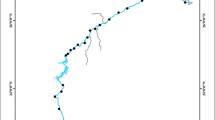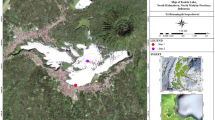Abstract
Assessment method for ecological condition of Xiangxi River system was studied by using 13 candidate metrics of epilithic diatom which can reflect conditions in pH, salinity, nitrogen uptake metabolism, oxygen requirements, saprobity, trophic state, morphological character and pollution tolerant capability etc. By one-way ANOVA, the metrics of relative abundance of acidobiontic algae (ACID), freshwater algae (FRESH), high oxygen requirement (HIGH-O), eutraphentic state (EUTRA) and mobile taxa (MOBILE) were suitable for distinguishing sites in different conditions. Then, the river diatom index (RDI) composed of these five metrics was used to evaluate ecological condition of the river. The results showed that the healthiest sites were in the Guanmenshan Natural Reserve (with the mean RDI of 79.73). The sites located in tributary of Jiuchong River also owned excellent state (mean RDI of 78.25). Mean RDI of another tributary – Gufu River and the main river were 70.85 and 68.45 respectively, and the unhealthiest tributary was Gaolan River (with mean RDI of 65.64). The mean RDI for all the 51 sites was 71.40. The competence of RDI was discussed with comparison of evaluation results of DAIpo and TDI, it can be concluded that multimetrics is more competent in assessment task.
Similar content being viewed by others
References
Bahls, L. L.: 1993, Periphyton Bioassessment Methods for Montana Streams, Water Quality Bureau, Department of Health and Environmental Sciences, Helena, Montana.
Barbour, M. T., Gerritsen J., Snyder, B. D. and Stribling, J. B.: 1999, Rapid Bioassessment Protocols for Use in Streams and Wadeable Rivers: Periphyton, Benthic Macroinvertebrates and Fish, Second Edition, U.S. Environmental Protection Agency; Office of Water; Washington, D.C.
Barbour, M. T., Stribling, J. B. and Karr, J. R.: 1995, ‘Multimetric Approach for Establishing Biocriteria and Measuring Biological Condition’, in: W. S. Davis and T. P. Simon (eds.), Biological Assessment and Criteria: Tools for Water Resource Planning and Decision Making, Boca Raton: Lewis Publishers, pp. 63–77.
Boyle, T. P. G., Smillie, G. M., Anderson, J. C. and Beeson, D. R.: 1990, ‘A sensitivity of nine diversity and seven similarity indices’, J. Water Pollut. Control Fed. 62, 749–762.
Chinese Environment Protection Bureau: 1989, Monitoring and Analyzing Methods for Water and Sewage, China Environment Science Press, Beijing (in Chinese).
Fore, L. S. and Grafe, C.: 2002, ‘Using diatoms to assess the biological condition of large rivers in Idaho (U.S.A.)’, Freshw. Biol. 47, 2015–2037.
Guzkowska, M. A. J. and Gasse, F.: 1990, ‘Diatoms as indicators of water quality in English urban lakes’, Freshw. Biol. 23, 233–250.
Hill, B. H., Herlihy, A. T., Kaufmann, P. R., DeCelles, S. J. and Borgh, M. A. V.: 2003, ‘Assessment of streams of the eastern United States using a periphyton index of biotic integrity’, Ecol. Indicators 2(4), 325–338.
Hill, B. H., Herlihy, A. T., Kaufmann, P. R., Stevenson, R. J., McCormick, F. H. and Johnson, C. B.: 2000, “Use of periphyton assemblage data as an index of biotic integrity’, J. N. Amer. Benthol. Soc. 19(1), 50–67.
Hu, H. J., Li, R. Y., Wei, Y. X., Zhu, H. Z., Chen, J. Y. and Shi, Z. X.: 1980, Freshwater Algae in China, Shanghai Science and Technology Press, Shanghai. (in Chinese).
Jiang, M. X.: 2001, Studies on pattern and function of riparian vegetation in Xiangxi River Catchment, Doctor degree dissertation of Institute of Hydrobiology, Chinese Academy of Sciences, Wuhan (in Chinese with English abstract).
Kelly, M. G., Adams, C., Graves, A. C., Jamieson, J., Krokowski, J., Lycett, E. B., Murray-Bligh, J., Pritchard S. and Wilkins C.: 2001, The Trophic Diatom Index: A User's Manual, Revised edition, Environment Agency, Rio House, Waterside Drive, Almondsbury.
Kelly, M. G., Penny, C. J. and Whitton, B. A.: 1995, ‘Comparative performance of benthic diatom indices used to assess river water quality’, Hydrobiologia 302, 179–188.
Kelly, M. G. and Whitton, B. A.: 1995, ‘The trophic diatom index: A new index for monitoring eutrophication in rivers’, J. Appl. Phycology 7, 433–444.
Kelly, M. G.: 1998, ‘Use of the trophic diatom index to monitor eutrophication in rivers’, Water Research 32(1), 236–242.
Kentucky Department for Environmental Protection Division: 2002, Methods for Assessing Biological Integrity of Surface Waters, Kentucky Department for Environmental Protection Division of Water Ecological Support Section, Kentucky.
Kerans, B. L. and Karr, J. R.: 1994, ‘A benthic index of biotic integrity (B-IBI) for rivers of the Tennessee valley’, Ecol. Appl. 4(4), 768–785.
Kwandrans, J., Eloranta, P., Kawecka, B. and Wojtan, K.: 1998, ‘Use of benthic diatom communities to evaluate water quality in rivers of southern Poland’, J. Appl. Phycol. 10, 193–201.
Lowe, R. L. and Pan, Y. D.: 1996, ‘Benthic Algal Communities as Biological Monitors’, in: R. J. Stevenson, M. L. Bothwell and R. L. Lowe (eds.), Algal Ecology: Freshwater Benthic Ecosystem, Academic Press Inc., San Diego, pp. 705–739.
McCormick, P. V. and O'Dell, M. B.: 1996, ‘Quantifying periphyton responses to phosphorus in the Florida Everglades: A synoptic-experimental approach’, J. N. Amer. Benthol. Soc. 15, 450–468.
Naiman, R. J. and Sedell, J. R.: 1980, ‘Relationships between metabolic parameters and stream order in Oregon’, Can. J. Fish. Aquatic Sci. 37, 834–847.
Pan, Y. D., Stevenson, R. J., Hill, B. H., Herlihy, A. T. and Collins, G. B.: 1996, ‘Using diatoms as indicators of ecological conditions in lotic systems: A regional assessment’, J. N. Amer. Benthol. Soc. 15, 81–495.
Patrick, R. and Reimer, C. W.: 1966, The Diatoms of the United States (volume 1), The Livingston Publishing company, Pennsylvania.
Patrick, R. and Reimer, C. W.: 1975, The Diatoms of the United States (volume 2, part 1), Sutter House, Pennsylvania.
Prygiel, J. and Coste, M.: 1993, ‘The assessment of water quality in the Artois-Picardie water basin (France) by use of diatom indices’, Hydrobiologia 269/270, 343–349.
Qi, Y. Z.: 1995, Flora Algarum Sinicarum Aquae Dulcis, Tomus IV, Bacillariophyta, Centricae, Science Press, Beijing (in Chinese).
Stevenson, R. J. and Pan, Y. D.: 2001, ‘Assessing Environmental Conditions in Rivers and Streams with Diatoms’, in: E. F. Stoermer and J. P. Smol (eds.), The Diatoms: Applications for the Environmental and Earth Sciences, Cambridge University Press, pp. 11–40.
Tang, T., Cai, Q. H., Liu, R. Q., Li, D. F. and Xie, Z. C.: 2002, ‘Distribution of epilithic algae in the Xiangxi River system and their relationships with environmental factors’, J. Freshw. Ecol. 17(3), 345–352.
Tang, T., Qu, X. D., Li, D. F., Liu, R. Q., Xie, Z. C. and Cai, Q. H.: 2004, ‘Benthic algae of the Xiangxi River, China’, J. Freshw. Ecol. 19(4), 597–604.
van Dam, H., Mertens, A. and Sinkeldam, J.: 1994, ‘A coded checklist and ecological indicator values of freshwater diatoms from the Netherlands’, Netherlands J. Aquatic Ecol. 28(1), 117–133.
Vannote, R. L., Minshall, G. W., Cummings, K. W., Sedell, J. R. and Cushing, C. E.: 1980, ‘The river continuum concept’, Can. J. Fish. Aquatic Sci. 37, 130–137.
Wang, J., Wang, B. S. and Luo, Z. Q.: 1997, Glossary of the Yangtze River, Wuhan Press, Wuhan (in Chinese).
Watanabe, T., Asai, K., Houki, A., Tanaka, S. and Hizuka, T.: 1986, ‘Saprophilous and eurysaprobic diatom taxa to organic water pollution and diatom assemblage index (DAIpo)’, Diatom 2, 23–73.
Watanabe, T., Asai, K. and Houki, A.: 1988, ‘Biological information closely related to the numerical index DAIpo (diatom assemblage index to organic water pollution)’, Diatom. 4, 49–58.
Zhang, Z. S. and Huang, X. F.: 1991, Research Methods for Freshwater Plankton, Science Press, Beijing (in Chinese).
Zhu, H. Y. and Chen, J. Y.: 2000, Bacillariophyta of the Xizang Plateau, Science Press, Beijing (in Chinese).
Author information
Authors and Affiliations
Corresponding author
Rights and permissions
About this article
Cite this article
Tang, T., Cai, Q. & Liu, J. Using Epilithic Diatom Communities to Assess Ecological Condition of Xiangxi River System. Environ Monit Assess 112, 347–361 (2006). https://doi.org/10.1007/s10661-006-7666-6
Received:
Accepted:
Issue Date:
DOI: https://doi.org/10.1007/s10661-006-7666-6




